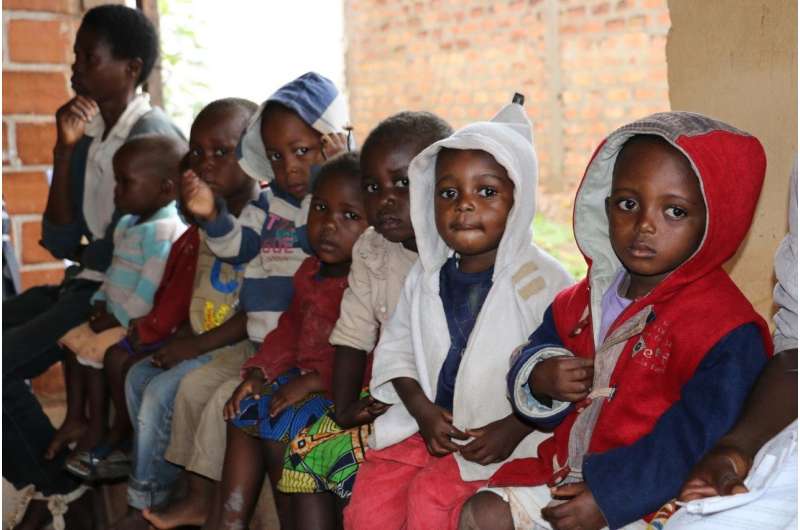August 27, 2018 report
Researchers report possible culprit in stunted childhood growth

Linear growth delay, in which normal growth in children is stunted, affects an estimated 155 million children around the world each year. Caused in part by malnutrition, it primarily affects children living in difficult economic conditions that expose them to sewage and waste. The pathophysiology of stunted growth is poorly understood, and to date, there are no available preventive or therapeutic strategies. The consequences of stunted growth carry on into adulthood, including decreased income potential and health complications.
Though nutrition is a known factor, researchers have theorized that the condition is also attributable to inflammation in the gastrointestinal system and an imbalance of the bacteria comprising the microbiota. In a new, multi-institutional study led by Pascale Vonaesch of the Pasteur Institute, researchers have collected evidence from a large cohort of children living in sub-Saharan Africa; Bangui, Central African Republic, and Antananarivo, Madagascar, suggesting that stunted growth could be caused by a massive overrepresentation in the intestine of bacteria that normally reside in the oropharyngeal cavity. The results are published in the Proceedings of the National Academy of Sciences.
Interestingly, although the Central African Republic and Madagascar are among the countries with the highest prevalence of linear growth delay, representing half of all affected children under the age of five, they have never before been included in an analysis of pediatric environmental enteropathy, the syndrome proposed as an underlying condition of stunted growth.
The study reports three major findings:
- the actual composition of small intestinal bacterial overgrowth (SIBO) in stunted children
- the similarity of microbiota in the intestines of these children with that of the stomach and duodenum
- a traceable microbiological signature of stunting in feces characterized by the overrepresentation of oropharyngeal species, which could be used for diagnosis
Additionally, these findings were conserved between the countries included in the study, indicating the probability that this common feature could be an underlying cause of stunted growth. The authors propose that stunting is strongly associated with "decompartmentalization" of the gastrointestinal tract characterized by overabundance of oropharyngeal bacteria that extends from the stomach to the colon.
This challenges the current view of stunting, in which recurrent infections by enteric pathogens inflame and overstimulate the small intestine. It also highlights the complicated relationship between the intestinal microbiome, metabolism, human development, and the surrounding environment.
The researchers write, "Our study confirms the suspected overrepresentation of enteropathogenic bacteria in the duodenum of stunted children, but extends the current picture by demonstrating a previously unknown microbial decompartmentalization of the oropharyngeal to gastrointestinal tract." They note that future studies should examine the mechanistic details of this process.
More information: Pascale Vonaesch et al. Stunted childhood growth is associated with decompartmentalization of the gastrointestinal tract and overgrowth of oropharyngeal taxa, Proceedings of the National Academy of Sciences (2018). DOI: 10.1073/pnas.1806573115
Abstract
Linear growth delay (stunting) affects roughly 155 million children under the age of 5 years worldwide. Treatment has been limited by a lack of understanding of the underlying pathophysiological mechanisms. Stunting is most likely associated with changes in the microbial community of the small intestine, a compartment vital for digestion and nutrient absorption. Efforts to better understand the pathophysiology have been hampered by difficulty of access to small intestinal fluids. Here, we describe the microbial community found in the upper gastrointestinal tract of stunted children aged 2–5 y living in sub-Saharan Africa. We studied 46 duodenal and 57 gastric samples from stunted children, as well as 404 fecal samples from stunted and nonstunted children living in Bangui, Central African Republic, and in Antananarivo, Madagascar, using 16S Illumina Amplicon sequencing and semiquantitative culture methods. The vast majority of the stunted children showed small intestinal bacterial overgrowth dominated by bacteria that normally reside in the oropharyngeal cavity. There was an overrepresentation of oral bacteria in fecal samples of stunted children, opening the way for developing noninvasive diagnostic markers. In addition, Escherichia coli/Shigella sp. and Campylobacter sp. were found to be more prevalent in stunted children, while Clostridia, well-known butyrate producers, were reduced. Our data suggest that stunting is associated with a microbiome "decompartmentalization" of the gastrointestinal tract characterized by an increased presence of oropharyngeal bacteria from the stomach to the colon, hence challenging the current view of stunting arising solely as a consequence of small intestine overstimulation through recurrent infections by enteric pathogens.
© 2018 Medical Xpress

















